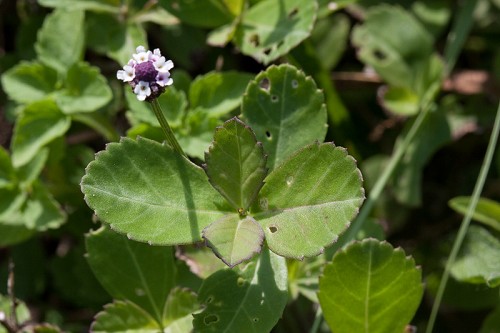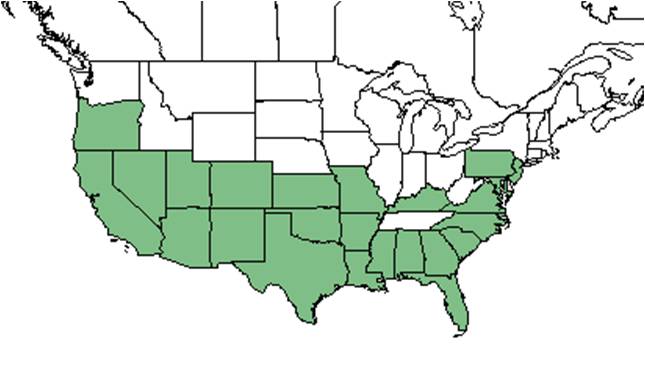Difference between revisions of "Phyla nodiflora"
(→Photo Gallery) |
|||
| Line 55: | Line 55: | ||
It is the larval host plant for the following butterflies: common buckeye (''Junoinia coenia''), phaon cresent (''Phyciodes phaon'') and white peacock (''Anartia jatrophae''). It is the nectar plant for the following butterflies: barred yellow (''Eurema daira''), ceranus blue (''Hemiargus ceraunus''), field skipper (''Atalopedes campestris''), gray hairstreak (''Strymon melinus''), little metalmark (''Calephelis virginiensis''), Miami blue (''Hemiargus thomasi''), Palatka skipper (''Euphytes pilatka''), phaon crescent (''Phyciodes phaon''), queen (''Danaus gilippus''), swarthy skipper (''Nastra lherminier''), tropical checkered-skipper (''Pyrgus oileus'')<ref name="regional"/>. | It is the larval host plant for the following butterflies: common buckeye (''Junoinia coenia''), phaon cresent (''Phyciodes phaon'') and white peacock (''Anartia jatrophae''). It is the nectar plant for the following butterflies: barred yellow (''Eurema daira''), ceranus blue (''Hemiargus ceraunus''), field skipper (''Atalopedes campestris''), gray hairstreak (''Strymon melinus''), little metalmark (''Calephelis virginiensis''), Miami blue (''Hemiargus thomasi''), Palatka skipper (''Euphytes pilatka''), phaon crescent (''Phyciodes phaon''), queen (''Danaus gilippus''), swarthy skipper (''Nastra lherminier''), tropical checkered-skipper (''Pyrgus oileus'')<ref name="regional"/>. | ||
<!--===Diseases and parasites===--> | <!--===Diseases and parasites===--> | ||
| − | |||
==Conservation and management== | ==Conservation and management== | ||
| − | |||
==Cultivation and restoration== | ==Cultivation and restoration== | ||
It can be used to treat hookworm. It is also a antibacterial, deobstruent, anodyne, parasiticide, and a diuretic<ref name="pfaf">[[http://www.pfaf.org/user/plant.aspx?latinname=Phyla+nodiflora]] Accessed: February 20, 2016</ref>. | It can be used to treat hookworm. It is also a antibacterial, deobstruent, anodyne, parasiticide, and a diuretic<ref name="pfaf">[[http://www.pfaf.org/user/plant.aspx?latinname=Phyla+nodiflora]] Accessed: February 20, 2016</ref>. | ||
| − | |||
==Photo Gallery== | ==Photo Gallery== | ||
<gallery widths=180px> </gallery> | <gallery widths=180px> </gallery> | ||
| − | |||
==References and notes== | ==References and notes== | ||
Chaudhary, B. A., M. Jabeen, et al. (2016). "PHYLA NODIFLORA (VERBENACEAE): A REVIEW." 2016 2(1): 6. | Chaudhary, B. A., M. Jabeen, et al. (2016). "PHYLA NODIFLORA (VERBENACEAE): A REVIEW." 2016 2(1): 6. | ||
Revision as of 19:22, 29 June 2016
| Phyla nodiflora | |
|---|---|

| |
| Photo by John R. Gwaltney, Southeastern Flora.com | |
| Scientific classification | |
| Kingdom: | Plantae |
| Division: | Magnoliophyta - Flowering plants |
| Class: | Magnoliopsida – Dicotyledons |
| Order: | Lamiales |
| Family: | Verbenaceae |
| Genus: | Phyla |
| Species: | P. nodiflora |
| Binomial name | |
| Phyla nodiflora (L.) Greene | |

| |
| Natural range of Phyla nodiflora from USDA NRCS Plants Database. | |
Common name: turkey tangle fogfruit
Contents
Taxonomic notes
Synonyms: Phyla nodiflora (Linnaeus) Greene var. nodiflora; Lippia nodiflora (Linnaeus) Michaux
Description
"Appressed pubescent, prostate to ascending or decumbent, perennial herbs, rooting at the nodes, obscurely to definitely 4- angled. Leaves opposite, serrate, base cuneate to attenuate; petioles to 0.5 mm long, often obscured by decurrent blade tissue. Inflorescence a bracteate head, in fruit a spike 8-15 cm long, 5-8 mm in diam., peduncles elongate, usually at alternate nodes and rarely in both axils at a node. Sepals united near base or for ½ their length, shorter than the corolla tube and the subtending bract; corolla zygomorphic, pinkish, lavender or rarely white, salverform, ca. 3 mm long, 5-lobes less than 1 mm long; stamens included, united to the corolla tube near middle at 2 levels. Fruit a schizocarp consisting of 2 mericarps. Mericarps yellowish tan, dull, orbicular to ovoid, rounded on one side and flattened on the other, 1-1.3 mm long." - Radford et al 1964
"Stems prostrate or decumbent, rarely more than 1 dm tall. Leaves oblanceolate, obovate or elliptic, 1-3 cm long, 0.3-2 cm wide, acute, base cuneate to attenuate. Peduncles 3-10 cm long, usually 2.5X or more as long as subtending leaves." - Radford et al 1964
Distribution
It is distributed throughout the United States, and can also be found in warmer parts of Asia, Africa, throughout India and Srilanka (Jabeen et al. 2016).
Ecology
Habitat
In the Coastal Plain in Florida, P. nodiflora has been observed growing in roadside hydric seepage bogs and exposed limerock (FSU Herbarium). Habitats are wet and moist with well-drained to poorly drained, sandy, limestone or organic soils without humus[1]. Associated species include Bidens, Polygonum, Cyperus and Ludwigia (FSU Herbarium).
Phenology
It has been observed flowering and fruiting in October (FSU Herbarium). Flowers are hermaphroditic[2].
Pollination
The following Hymenoptera families and species were observed visiting flowers of Phyla nodiflora at Archbold Biological Station (Deyrup 2015):
Apidae: Apis mellifera
Halictidae: Augochloropsis metallica, Halictus poeyi, Lasioglossum lepidii
Megachilidae: Anthidium maculifrons, Coelioxys mexicana, C. texana, Megachile brevis pseudobrevis, M. mendica
Sphecidae: Ammophila urnaria, Bicyrtes insidiatrix, Prionyx thomae
Use by animals
It is the larval host plant for the following butterflies: common buckeye (Junoinia coenia), phaon cresent (Phyciodes phaon) and white peacock (Anartia jatrophae). It is the nectar plant for the following butterflies: barred yellow (Eurema daira), ceranus blue (Hemiargus ceraunus), field skipper (Atalopedes campestris), gray hairstreak (Strymon melinus), little metalmark (Calephelis virginiensis), Miami blue (Hemiargus thomasi), Palatka skipper (Euphytes pilatka), phaon crescent (Phyciodes phaon), queen (Danaus gilippus), swarthy skipper (Nastra lherminier), tropical checkered-skipper (Pyrgus oileus)[1].
Conservation and management
Cultivation and restoration
It can be used to treat hookworm. It is also a antibacterial, deobstruent, anodyne, parasiticide, and a diuretic[2].
Photo Gallery
References and notes
Chaudhary, B. A., M. Jabeen, et al. (2016). "PHYLA NODIFLORA (VERBENACEAE): A REVIEW." 2016 2(1): 6.
Deyrup, M.A. and N.D. 2015. Database of observations of Hymenoptera visitations to flowers of plants on Archbold Biological Station, Florida, USA.
Florida State University Robert K. Godfrey Herbarium database. URL: http://herbarium.bio.fsu.edu. Last accessed: October 2015. Collectors: Loran C. Anderson, Robert K. Godfrey, Karen MacClendon, R.A. Norris. States and Counties: Florida: Calhoun, Franklin, Gadsden, Holmes, Leon, Liberty, Monroe, Taylor. Compiled by Tall Timbers Research Station and Land Conservancy.
Radford, Albert E., Harry E. Ahles, and C. Ritchie Bell. Manual of the Vascular Flora of the Carolinas. 1964, 1968. The University of North Carolina Press. 892-3. Print.